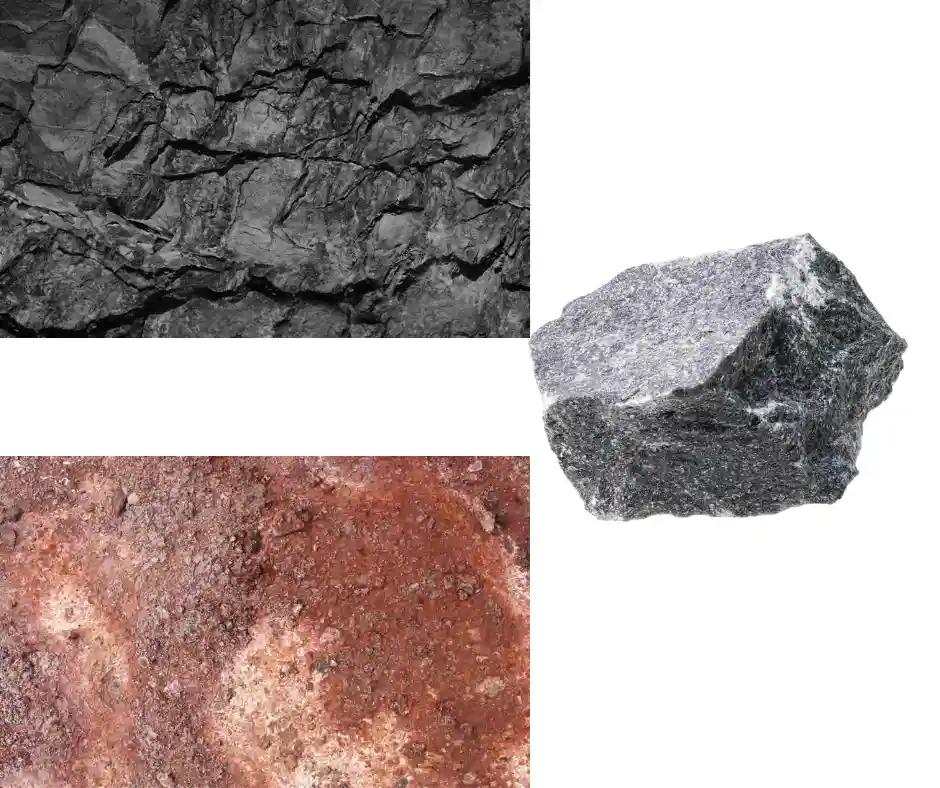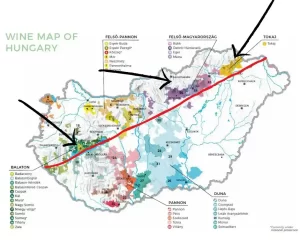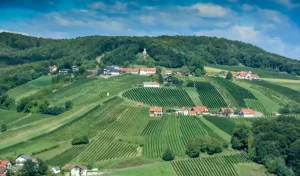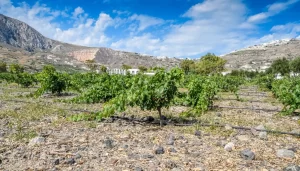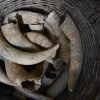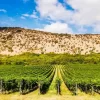Erupting with Flavour
Volcanoes have always fascinated me whether from climbing Mount Kilimanjaro in Tanzania, Mount Fuji in Japan or visiting the fabulous vineyards on volcanic hills. It’s not just the geological impact and flavour profile or texture that will affect the finished product. Also the mysticism and secrets underneath the surface and challenges for the vine itself. It is a challenge for nature and humans alike, but the results are fascinating, you often want to visit the regions after tasting their wines. Let’s explore some of these areas in Europe.
Volcanic Wines Unveiled: Exploring Hungary’s Terroirs from Mátra to Balaton
Hungary is particularly fascinating as it has 37 PDOs and with the overlapping appellation, it has more than 10 which have significant formations of volcanic soil. Throughout, Tokaj is known, and here you can most easily experience the distinction between wines from the same producer on loess soil and rhyolite. Pick a winemaker who has vineyards in Tarcal and Mád and makes pretty much identical vinification yet the taste will be different. Of course, nature is different and climate, weather as well and all the detailed nuances in the soils from organic to inorganic are different as well. Absolutely!
In Hungary, one can almost draw across the vertical line (below in red) along Lake Balaton and point out that north of the line is the tertiary volcanic rock, Mesozoic vulcanite. In the early Miocene acid volcanism (tuff, rhyolite) was characteristic. While Bükk and Eger are also volcanic, andesite, and rhyolite tuff, and the major soils, the Mátra seem to be standing out in many ways. Foremost it is a lost, hidden treasure. I was talking with Daniel Kedzy in my podcast (in Hungarian) about this unfortunate.
Sár – hegy
stands out for many reasons, along the fault like the Kékes it is comprised of andesite, tuff and andesite conglomerates. It’s been protected by the Mátra mountain range from the cold Northern winds and is fairly close to the big city Gyöngyös (benefits from heat). The Sár Hegy looks bigger than it is (200 m), as it stands out like an island.
The other part runs along the Gyöngyöspata basin just West of Gyöngyös. The soil here is more about iron, and manganese oxides, followed by rhyolite tuff and andesite as well. Vineyards are usually southeast facing, the commune of Pata and Tarján.
While there are true potential exists through certain producers and Mother Nature, the number of terroir-focused winemakers is small. I would draw comparisons with Alsace for the finest wines. A focus on single vineyard could easily be implemented not to mention go even a step further and highlight communes as appellation.
The north shore of the
Balaton runs technically speaking from Balatonfőkajár in the East to Keszthely in the West. Truly volcanic soils to be found:
- on the peninsula of Tihany (7 million-year-old volcano, rich tuff rock and silica, carbonate)
- Kál (Triassic basalt, high magnesium and iron content, with marl and limestone)
- Badacsony (basalt, tuff, sandstone)
- and of course, Somló which is part of the region.
Austrian Elegance from Volcanic Soil: Wines of Distinctive Character – Vulkanland Steiermark
Whoever came up with the idea to change Südoststeiermark into Vulkanland should be awarded a medal. You may call it politically Südoststeiermark, but Vulkanland is better for all the reasons.
The Tethys Ocean, which lay between the two continents, nearly vanished as a result of the northward drift of the African continent. Which also resulted in the creation of the Alps. A new marginal sea called the Paratethys emerged before the folding of the Alps approximately 34 million years ago. It was divided into three regions: the western, central, and eastern Paratethys, and it stretched from the present-day Rhône region to the Aral Sea. Along with Vienna, Graz, and the Pannonian Basin, Vulkanland Steiermark is located in the centre of the Paratethys. The second and most powerful phase of volcanism within this area started, 2.8 million years ago. Volcanoes that resemble a string of pearls, including the Königsberg, Stradner Kogel, Kapfenstein, Riegersburg, and the Klöcher Vulkan.
If you compare the same varieties between Südsteiermark and Vulkanland, generally the wines from the Vulkanland tend to have more weight, spicy texture, higher alcohol riper in fruit and share a gritty notion. Regarding the acidity (talking only about the white wines) they’re not necessarily higher, but share a rounder texture and are less linear or zesty in style than the wines from the Südsteiermark.
Vulkanland Steiermark
is a DAC appellation system, the Eruption Winzer went even a step further. Above Riedwein (single vineyard) they introduced Erste Lage (like 1er Cru) and Grosse Lage (like Grand Cru). In their Grosse Lage only Chardonnay, Pinot blanc, Pinot gris, Sauvignon blanc, Traminer, and Riesling are permitted.
The wines are fascinating and not only excel through the purity of fruit but also the very notion of the soil adds this dimension to the finished wines.
Santorini’s Liquid Lava: Unearthing the Magic of Volcanic Wine
The island is a must-visit for every wine aficionado. Not only has it so many quality-minded producers but also incredible history, natural and human wise as well. Assyirtiko, Vin Santo, a mix of red wines, old vines, pumice (fine-grained volcanic rock with low density) and the people. Some of the generic reasons behind the fascinating wines of the island. There are plenty of challenges on the island (wind, water, humidity, sun, and more…) to cope with as a vine and wine producer as well. But this „struggle” is necessary to deliver something stunning and interesting.
Tasting at Argyros Estate
Tasting the 2001 Vin Santo late releases from Estate Argyros made me instantly think this is the wine I would like to visit the place of its birth. Led by Assyrtiko from over 200-year-old ungrafted vines, super low yield. The grapes dried in the sun outside on some plastic mats next to the vines for 2 weeks, long natural fermentation and then matured in a different origin, size and materials before release. They produce fewer than 5,000 bottles, but it inspires a desire in you to visit and learn more about the nature and people of Santorini.
Volcanic wines of Tenerife
The largest of the Canary Islands Tenerife has several DOs:
- Tacoronte-Acentejo: in the North-East part of the island, characterized by lush landscapes and moderate maritime influences, from 100 to 1000 m in altitude 1800 ha in total, mainly terraced.
- Ycoden-Daute-Isora: known for terraced vineyards up to 1400 m in elevation considered the warmest. Listán Blanco, Negramoll, and Tintilla are the main varieties. Beautiful landscape and some very fine wines are produced here.
- Abona: situated in the southern part of Tenerife over 2000 ha of vineyards with an elevation of up to 1800 m. Abona focuses on red wines primarily from Listán Negro, as well as whites from Listán Blanco.
- Valle de Güímar: benamed after the valley with ca. 750 hectares. Home to diverse soil types, this DO crafts distinctive wines from grapes like Listán Blanco, Listán Negro, and Malvasía.
- Valle de la Orotava: named after the town of Orotava along the NW coast covering 700 ha. Some of the most exciting wines are produced here. The traditional cordon trenzado training system is practised.
While I’m always a big advocate for individual GIs. I wouldn’t mind if there would be also a generic (PGI) for Tenerife. Honey (Miel de Tenerife) has it so why not wine? Make it first simple and complicate it later.
Mountains, volcanoes, local varieties and more
Tenerife’s vineyards span a remarkable range of altitudes, from coastal plains to steep hillsides, leading to varied climate patterns. Coastal areas experience milder conditions due to proximity to the Atlantic Ocean, while elevated terraces contend with greater temperature shifts. This diversity, combined with the island’s exposure to winds, plays a crucial role in crafting wines. The unique aromatic profiles, balanced acidity, and distinct minerality are unique.
One of the best examples I ever tasted is from 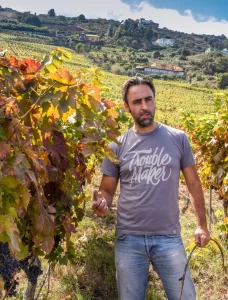
Jonatan Garcia. Who runs the Suertes del Marques Winery based in the Orotava Valley.
The wine in name was a 2013 Trenzado a blend of mainly Listán Blanco from very old vines. Cultivated by the earlier mentioned Cordón Trenzado method. Fresh, vibrant acidity, waxy texture with restrained fruit but overt spicy, salty mineral edge. Aged usually in larger oak barrels.
The wines tasted with Jonatan back at his place had this vibrancy of acidity, and mineral tone followed by a sublime matchstick note. A precision of reduction, just walking along a narrow ledge. The winery does virtually everything „by hand” and maintains a great respect towards nature and the culture of the region.
Volcanic soil classification
There are many different ways to categorise volcanic soils in the wine world. From age (young vs. old) to location (islands vs. mainland). You may want to draw a category based on soil composition.
Basaltic rocks
have relatively low silica content and higher levels of iron and magnesium. This composition results in more fluid magma during volcanic eruptions. When basaltic lava flows and cools, it forms dark-coloured rocks. Basaltic soils are typically rich in minerals, making them fertile.
Silicic rocks
like granite and rhyolite, have high silica content but lower iron and magnesium levels. This results in thicker magma during volcanic activity. Silicic soils tend to be less fertile due to lower mineral content, and they can also be less well-draining.
Between them, you may place dacite and andesite.
Volcanic soils will continue to fascinate me from nature to grape growing and winemaking. They are special for many reasons, so keep tasting them and visit the regions. For more info keep following me on my social media accounts.

